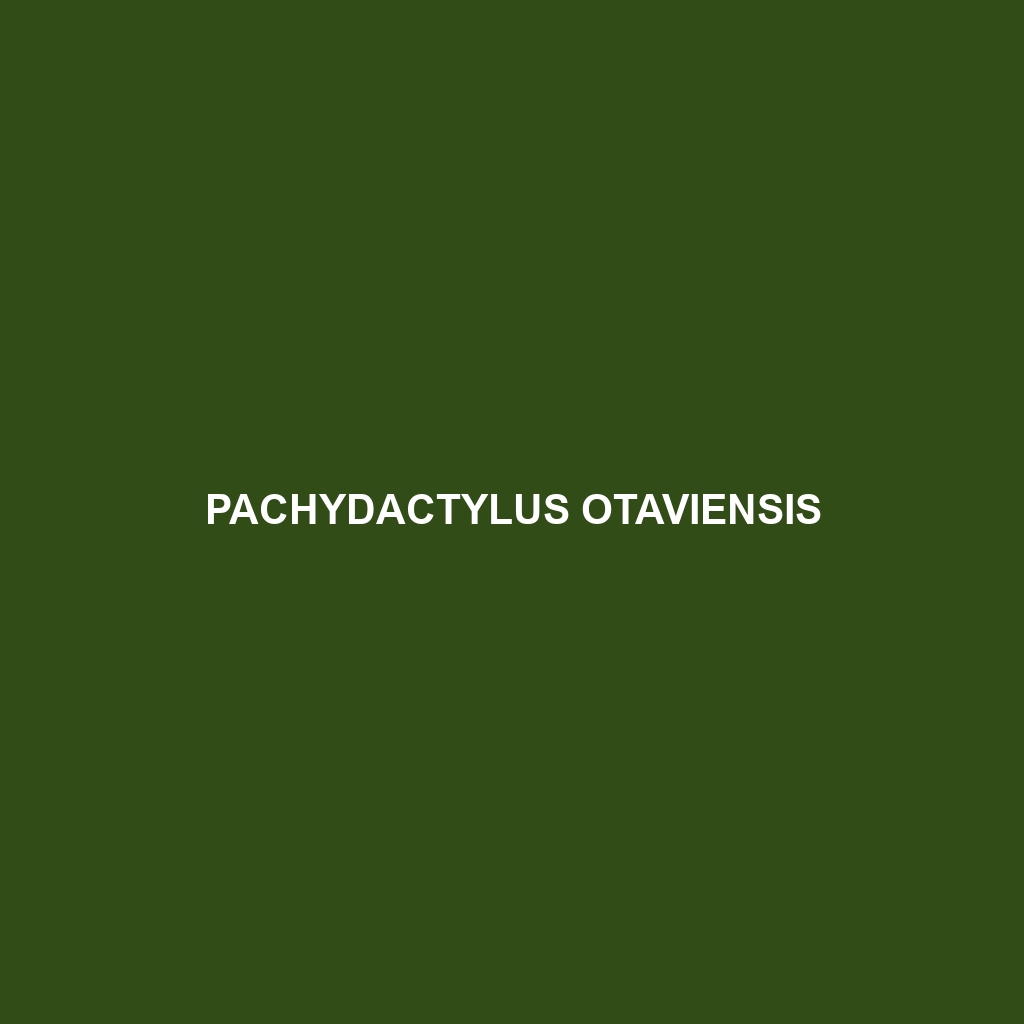Common Name
Pachydactylus otaviensis
Scientific Name
Pachydactylus otaviensis
Habitat
Pachydactylus otaviensis, commonly known as the Otavi thick-toed gecko, is primarily found in the arid and semi-arid regions of Namibia, particularly in the Otavi Mountains and surrounding areas. This gecko thrives in environments characterized by rugged terrain, rocky outcrops, and sparse vegetation. The climate in these regions is classified as semi-arid, featuring extremely hot summers and mild winters. The gecko is often discovered in habitats such as sandy soils, dry savannas, and areas with exposed rocks which provide ample opportunity for shelter and hunting. These geographic and climatic conditions contribute to a unique ecosystem in which this species plays a vital role.
Physical Characteristics
Pachydactylus otaviensis exhibits a distinctive morphology that allows it to adapt efficiently to its environment. Typically, this gecko measures between 10 to 12 centimeters in length. Its body is relatively stout with thick toes that are specially adapted for climbing and gripping surfaces, which is reflected in its name. The coloration of the Otavi thick-toed gecko varies, typically featuring a pattern of light brown to sandy beige with darker spots and stripes that provide excellent camouflage against the rocky terrain. Its large, bulbous eyes enhance its nocturnal vision, making it well-suited for its primarily nocturnal lifestyle. Unique attributes such as its enlarged toe pads and specialized scales aid in locomotion, enhancing its ability to navigate the rugged landscape.
Behavior
The behavior of Pachydactylus otaviensis is notably adapted to its environment, with most activity occurring during the cooler nocturnal hours. These geckos are known for their elusive nature, often remaining hidden during the hot parts of the day. Social interactions among geckos are primarily centered around territory establishment and mating. Males are known to engage in visual displays to assert dominance over a territory, often involving head bobbing and tail waving. Mating rituals typically occur during the warmer months, coinciding with the gecko’s peak activity periods. Understanding these aspects of their behavior helps illuminate the survival strategies employed by this species in harsh environments.
Diet
Pachydactylus otaviensis is primarily insectivorous, feeding mainly on a diet composed of various insects and arthropods found in its habitat. This gecko employs a sit-and-wait hunting strategy, where it remains still and camouflaged until prey approaches. Once within striking distance, it utilizes a quick lunge to capture its food. Its diet may also include small invertebrates that share its rocky environment. As an insectivore, the Otavi thick-toed gecko plays a crucial role in controlling insect populations, which is essential for maintaining ecological balance.
Reproduction
The reproductive cycle of Pachydactylus otaviensis generally occurs during the late rainy season, which enhances the availability of resources for both mating and nurturing young. Mating is often preceded by elaborate courtship displays between males and females. After successful mating, females typically lay between two to four eggs per clutch in sandy substrate or in crevices where they provide some protection from potential predators. The incubation period lasts approximately 60 to 90 days, after which the hatchlings emerge, fully independent and equipped to survive in their environment. This reproductive strategy allows for a steady population of geckos, aiding in the stability of their ecological niche.
Conservation Status
The conservation status of Pachydactylus otaviensis is currently listed as of ‘Least Concern’ by the International Union for Conservation of Nature (IUCN). However, this gecko, like many species, faces challenges due to habitat destruction caused by agricultural expansion and climate change. Conservation efforts focus on habitat protection and the implementation of sustainable land-use practices in the regions it inhabits. Awareness campaigns are also essential to educate local communities about the importance of this species to their ecosystems.
Interesting Facts
Pachydactylus otaviensis is notable for its exceptional adaptability to desert conditions. One fascinating adaptation is its ability to conserve water, which is essential for survival in its arid habitat. Additionally, this species uses its coloration for camouflage, allowing it to evade predators effectively. Observations suggest that this gecko may also engage in communal basking, where individuals gather sunny spots on rocks to regulate their body temperature—a behavior that demonstrates a degree of social interaction uncommon among reptiles.
Role in Ecosystem
Pachydactylus otaviensis plays a significant ecological role as a predator within its habitat. By controlling insect populations, it helps maintain a balanced ecosystem, preventing outbreaks of pests that could affect vegetation and other animal populations. This gecko also serves as prey for larger predators, thereby contributing to the food web dynamics of its environment. Its existence reflects the health of the ecosystem; a decline in their population may indicate negative changes in environmental conditions.
